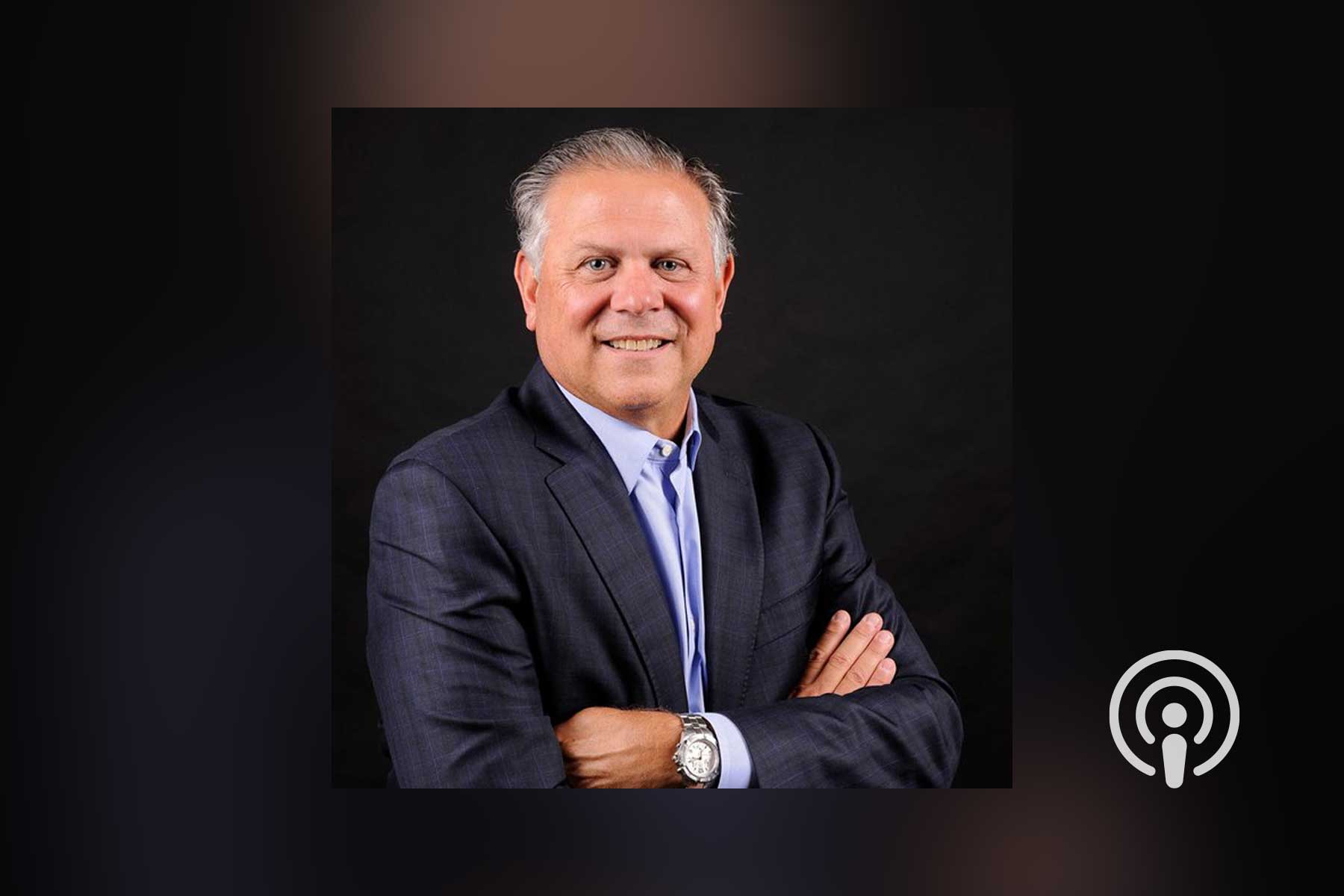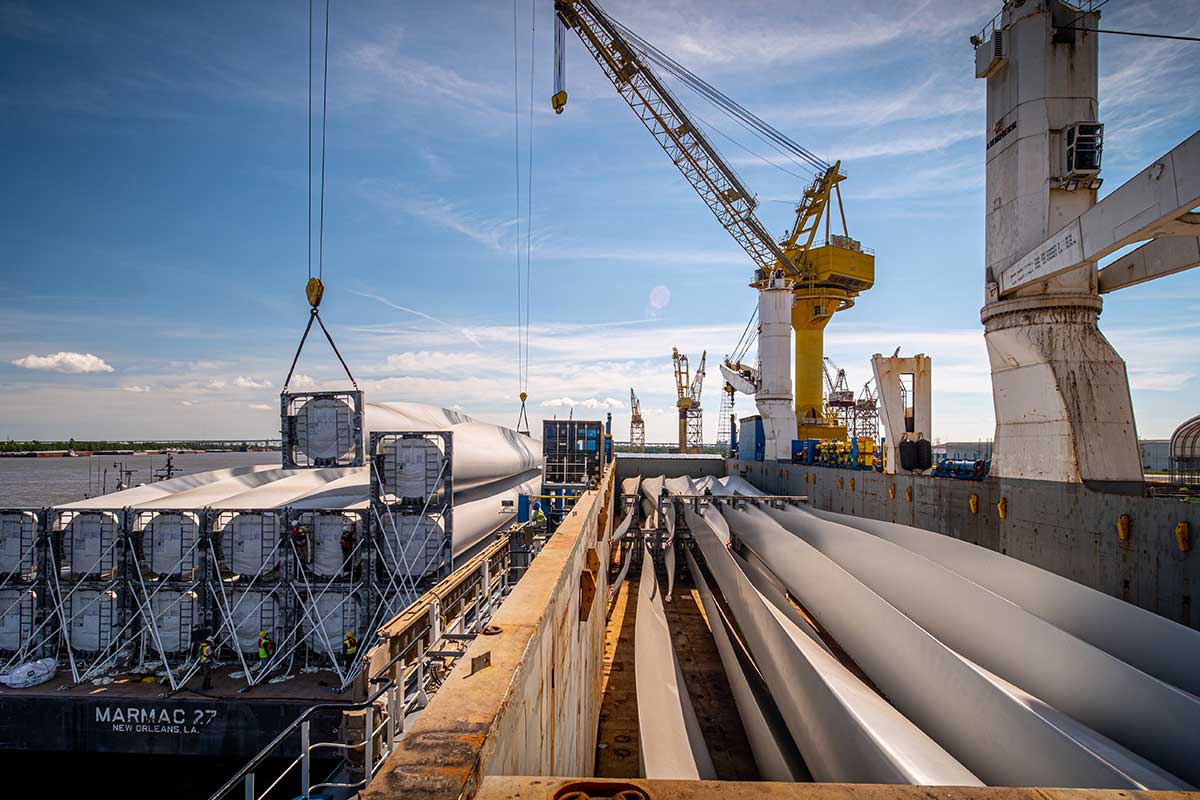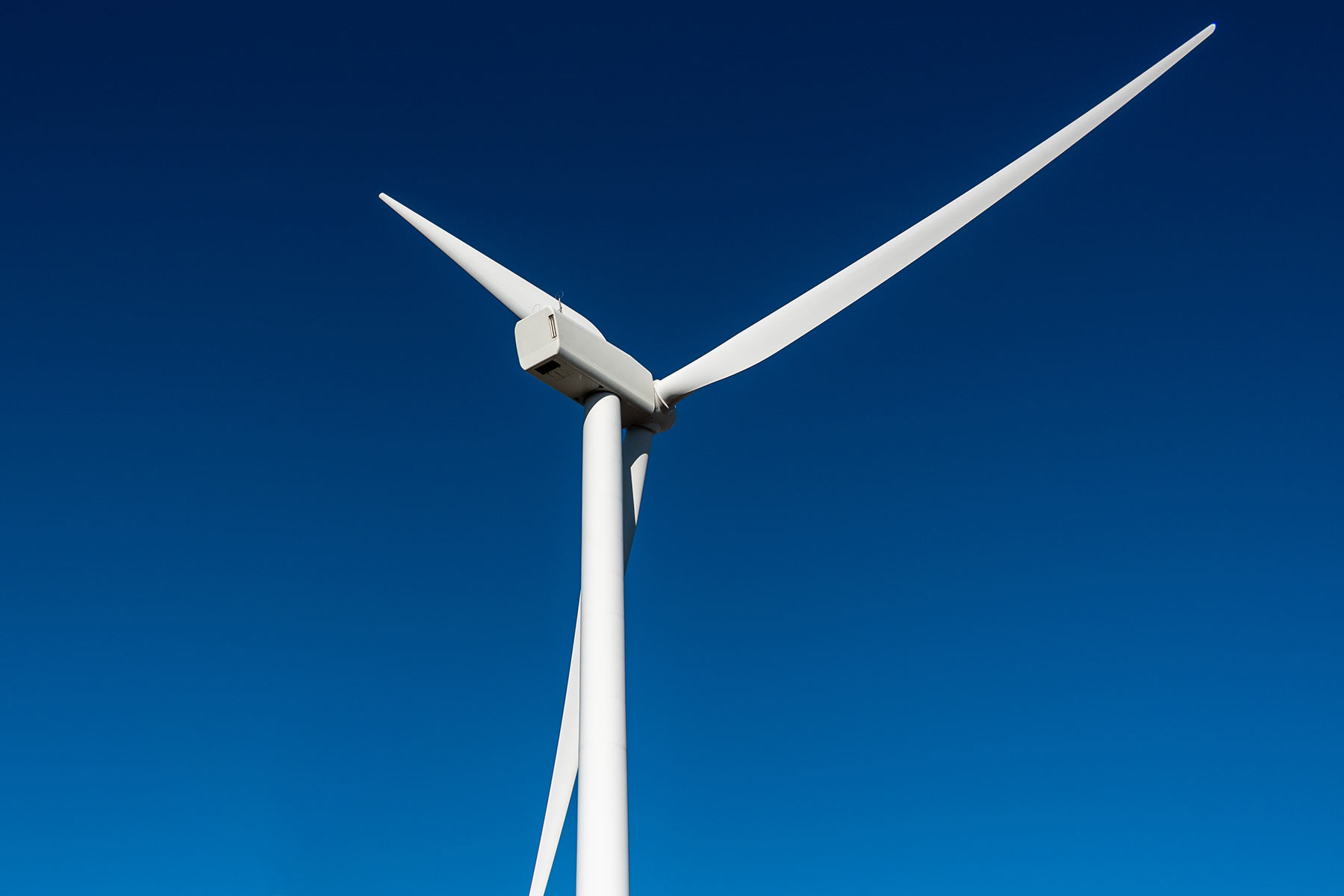Our CEO, James Martin, along with Jeff Keever, Government Affairs Representative at T. Parker Host, joined Newell Norman on his GNO Inc. Hour podcast to discuss the arrival of Louisiana’s first wind turbine component at Avondale Global Gateway.
Transcript:
We’ve, we’ve got some guests and, and I think the thing is, so, so this is, these are two great guys. One is Jeff Keever. He is one of our leaders at T Parker Hosts who own and run, Avondale. And, and the second is James Martin, who is the CEO of Gulf Wind Technology. And although, although James is actually English, given that they’re going to be talking about a wind turbine that’s arrived at Avondale from Ireland, maybe you could ask him to put on an Irish accent and see if we have like a.
Like a Chet Hanks moment on the radio. No, these two guys are real players and not play actors like Michael Hecht, so let’s keep it serious. No, no, no, no, these guys are actually, no, I’m kind of like the intro, and these guys are actually the real act, you know, I’m just the That’s right. All right, gentlemen, we’re gonna get, we’re gonna get serious now.
Jeff Keever, James Martin, thank you so much for joining us. Obviously, this is exciting news. Louisiana’s first wind turbine and its components have actually arrived at Avondale Global Gateway after coming across the Atlantic from Ireland. A lot to be excited about.
Well, firstly, top of the morning to you, Michael Newell, and, uh, Well played. It’s all I can do with the Irish accent. But, uh, no, we’re, we’re really excited to have this, you know, at the, at the factory, Avondale Global Gateway. You know, it’s the first, It’s not a giant turbine, but it is a turbine, and we got the pressure test all of the logistics, the expertise of, uh, Avondale, using all the equipment rolling in front of the factory and just sort of making light work of step one of this project.
So, yeah, really excited about it. So, and and can I just interject here? I think this is a complete demonstration while it is a smaller wind turbine, is a complete demonstration of the existing infrastructure that is in place to accommodate the needs. Not only the onshore wind market, but what’s coming with the offshore wind market.
And, it says to the to the world that Louisiana is capable of handling this type of these types of large components as, uh, as this industry ramps up and throughout the United States. So this is a 187 foot turbine, uh, James or Jeff, either one, if you would, for the benefit of the listening audience, put that in context as to how big these things can potentially be.
So, I guess 187 foot for this turbine, that’s from the ground to the tip of the blade. You know, it is really a baby turbine. It’s basically been selected to it. It’s gonna be doing a lot of technology demonstration. There’s gonna be a lot of data. It doesn’t want it. We don’t want to offend any of the key stakeholders.
We’ve had fantastic support from Port Fourchon and the team in Lafourche Parish, and this is really Designed to be the path of least resistance to demonstrate the most moving parts of, logistics and community engagement to get this one up. But in terms of scale, Newell, I mean, the blades of your standard onshore turbine are the same length as the whole height of this unit.
And those blades are, you know, half to a third of the giant offshore wind turbine. So you know, these turbines have really grown over the last couple of decades. This particular unit is approximately 10 years old. So we’ve got something that’s got a little bit of mileage, but it is a proven. high wind speed, resistant base unit.
And so we did, you know, we want it to be low risk. The whole point of this first time on its low risk. We get to demonstrate Louisiana made components on it. And yeah, hopefully, when that is successful, we can move into The next unit, which will be a little bit more representative of the more advanced technology on the market.
And I guess, uh, both to James and Jeff, I mean, this is going to provide the empirical data necessary moving forward. You know, uh, evidence based outcome, all of those buzzwords, uh, to have people embrace the utilization of this technology in this region of the country. Absolutely. I mean, go ahead.
The sort of engagement we’ve got so far, and if you imagine this, we’ve got, we work a lot with STEM programs. I know we work a lot with GNO, so through Michael’s organization, GNO Inc., we’ve been made some fantastic connections with. The schools with colleges with universities and you know, the aim is this is an opportunity for people to get up close and personal to understand what it takes to build a foundation to transport a tower.
Uh, actually was down at the oilman’s rodeo fishing a couple of weeks ago and, got to go down the actual, the bayou that this, you know, the barge will actually travel from Avondale down to Down to Port Fourchon. It’s a not. It’s a showcase. You know, we get to put these components on a barge. We work with the, the tub companies will work with the crane companies, the local engineering companies to build and assess the soil conditions, the foundation.
So it’s really going to engage everyone, you know, from teenagers to experience, you know, oil and gas professionals and just, you know, people can kick the tires. They’ll see what we’re doing. It’s what they call a behind the meter offtake agreement. So it’s really just, uh, helping to supply power to some of one of the Port Fourchon’s projects at the Coastal Wetlands Park, and it’s a small amount of power in the scheme of things.
But it demonstrates every ingredient. That’s the aim. Jeff, go ahead. Yeah, I mean, I just want to underscore that. That same point is that we’ve already received it from the global marketplace. And once James and his team that team at Gulf Wind Technology complete their tweaks to this so that they’re able to collect the important data That will be collected as a result of this with wind speeds, velocities and the overall impact.
We will, we will move this as James said down to Sushant and that completes the entire process. Once it’s installed that the workforce in Louisiana is quite capable of handling the the transportation is a non issue either into Louisiana or to its ultimate place of the installation. And while this is a small one and onshore facility, as the offshore wind develops in this case, We envision that those components, those very, very large components that James talked about earlier, would be brought into, imported into Avondale, stored on site, again, tweak some assembly, some sub assembly that would occur there, and then move it down to Fushon for the installation out in the Gulf of Mexico.
A fully integrated supply chain, uh, for, uh, the Gulf of Mexico currently exists. Right here in Jefferson Parish folks. We’re visiting with Jeff Kiefer, uh, government affairs rep at T Parker host, representing Avondale Global Gateway and James Martin, CEO of Gulf Wind Technology. Got to get to a break. We’ll be right back.
Stay with us. Welcome back, folks. We’re visiting with Michael Heck, president and CEO of G and O Inc. Jeff Kiefer, government affairs representative at T Parker host and James Martin, CEO of Gulf Wind Technology. With the economic headwinds that we have today, I mean, it’s really heightens the importance of and I’ll just call this an exercise for lack of, you know, just because of my ignorance.
But, I mean, even though that we don’t have the windfields that has been talked about on the east coast, do you get a sense that the cost of construction and implementation here will be cheaper than what it would be on the east coast? Yeah, it’s a really good question, Nolan. I think we do a lot of work with onshore wind.
I mean, there’s almost 90, 000 onshore wind turbines in North America today, and we get involved with a lot of projects all over the states. So, you know, the turbines are the common ingredient. So a turbine is a turbine and some of the, they’re different sizes, but then you’ve got, for offshore winds, you’ve got all the additional construction costs, the cable laying, the, the jackets and the, all the mono piles and the foundations.
And yeah, there certainly is a lot of challenge on construction. I think what we’ve got in Louisiana and again and this is a pretty well driven message, but we’ve got an opportunity to be in the manufacturing and the dish and the export business for wind turbines because there’s such a, there is such a demand for them.
They are, there’s economic tailwinds, you know, to say in certain regions wherever there’s high wind speed, you’re going to get a turbine and places like the Gulf of Mexico, where there’s the low wind speed, it’s going to come. You know, the technology will demonstrate it. The product will be there and the market will open up.
But what on your modeling we’ve done is where we’ve really got an add up. And this is whether we’re putting them in our backyard in the Gulf or we’re shipping them up the Mississippi, is that logistics and manufacturing is really one of our jewels in the crown. You know, we’ve got a fantastic workforce that has been manufacturing, whether it’s in shipyards, whether it’s out in oil and gas industry, whether it’s, we’ve got all the supporting training and infrastructure for that workforce.
And then you can move things around. I mean, Michael talks about this a lot, but there’s a lot of Louisiana companies that are up getting business on the East Coast doing well, you know, Louisiana jobs, you know, deploying in the on the East Coast. And so we’ve got all of the ingredients to reduce the cost.
Of those turbines by, you know, a good, good number of percentage points that can put us in the game, whether we’re exporting or whether we’re putting him in our backyard. So we got a lot of we got a lot of things to celebrate on that front. Absolutely. That’s a great news. Jeff. Final comments. Oh, I would underscore that explicitly.
I mean, I think that’s one of the reasons James is located on our site because of access to the river and both coasts as well as the Gulf of Mexico, and we see that as a big, big opportunity to feed the East Coast and capitalize on the success of a number of Louisiana companies. That have already been engaged in that, development on on the east coast.
And as the west coast begins to develop as well. So the workforce, Louisiana has been a leader in energy for decades and can continue to lead that charge in this new opportunity for offshore wind. Absolutely. James, let me just say my audience says that you pronounce Port Fourchon better than 90 percent of New Orleanians.
So congratulations.
I noticed that. I’ve really, I’ve really enjoyed getting to know the team down there and the whole board of commissioners. They’ve been hugely supportive. And, yeah, I’ve got to meet everyone down there and yeah, I’ve got to. I’ve got to walk the talk for sure. Well, guys, congratulations and thank you so much for joining us today.
We really appreciate it. Have a great week, Michael. Final thoughts. Yeah. Thank you, James and Jeff, yeah, look, this Sunday kicks off a tales of the cocktail. It’s basically. The Davos of Drink, the biggest international conference around a two trillion dollar industry. So I would beseech everybody to help support the economy this weekend, uh, starting off at the Rich Carlton, uh, with Tales of the Cocktail.
But then wherever beverages are sold, we all have to do our part, Newell. Well, I’m waiting for my invite from you to the Davos of Drink. Only you.
Alrighty, Michael. Heck, we move on. Thank you so much for joining us, which we always appreciate your time and your insight. Have a great week, my friend. We will be right back folks. 504 260 1870 on the Oakwood heart talking jeweler line. We stay with us.




